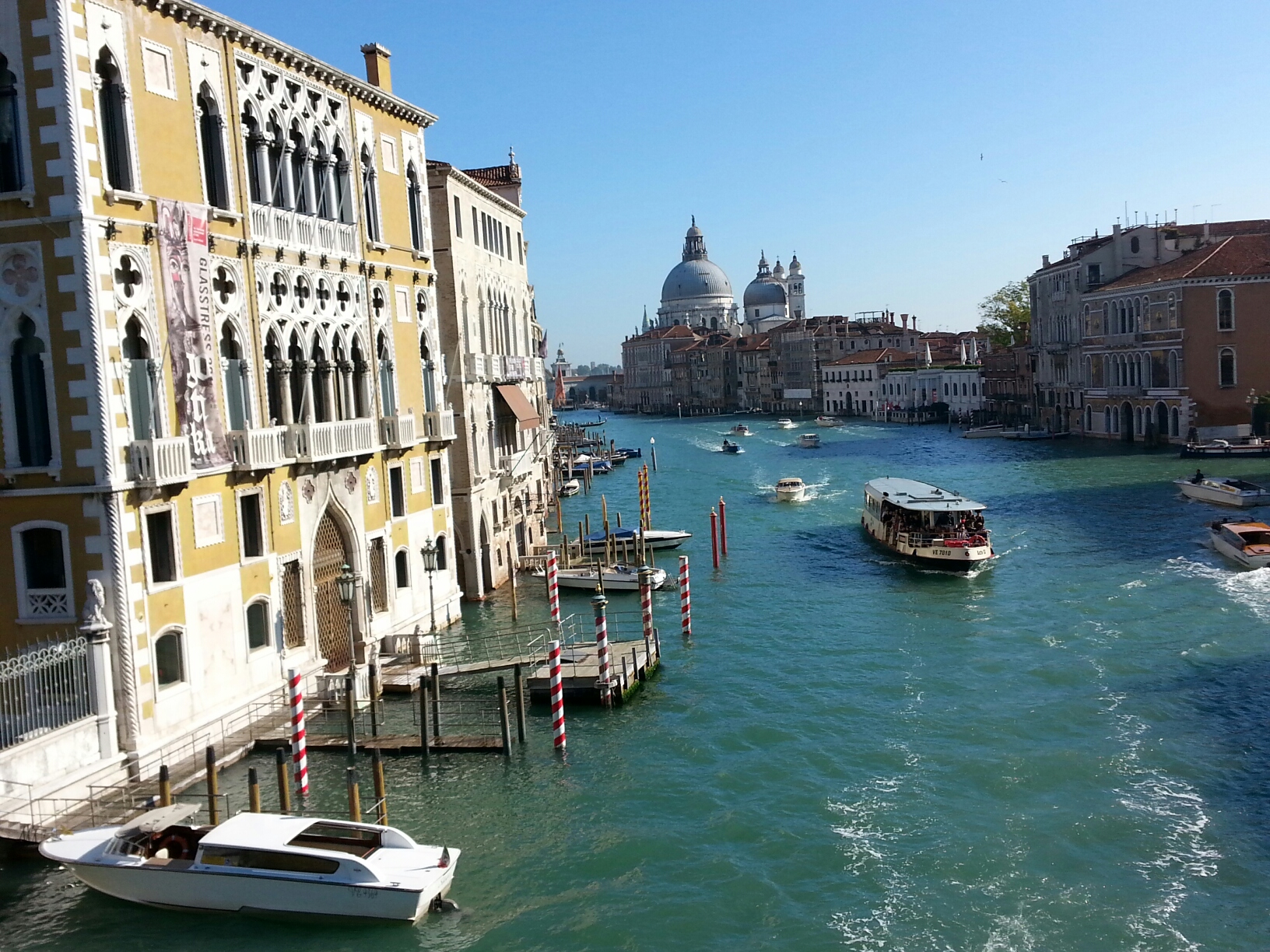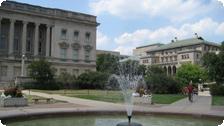It seems like only yesterday when as a college student I set off on a summer European adventure. With a backpack and my train pass in hand, I covered seven countries in three months. Venice, Northern Italy’s “Queen of the Adriatic”, a unique and majestic city built on an archipelago of small islands, was among my favorite discoveries that year.
Surprisingly, it took me nearly 30 years to return. In late October 2015, I was happy to find the fairy tale city still intact contradicting reports of its demise. Thankfully for the world, Venice has not yet been swallowed up by the sea and continues to thrive as an artistic center and top tourist destination.
This time around, I navigated my way from the airport on the mainland to the heart of the city via public ground transportation. The airport bus, only 8 Euros one way, was affordable and easily accessible from baggage claim. Travel time was under 40 minutes. Keep in mind, if you have larger and multiple pieces of luggage, the bus may not be a good match. There is limited baggage space and seating can be scarce during peak season.
Resource Spotlight: “Europe for Visitors” online explains transportation options for visitors and the process. The website provides useful and comprehensive information that I could not possibly cover in this short post.
Excerpt:
Riding a vaporetto, motoscafo, or motonave in Venice isn’t any more complicated than riding a subway or city bus.
A recommendation:
Buy an “Aerobus & Nave” ticket (€14): Valid for the ACTV No. 5 “Aerobus” between Marco Polo Airport and the Piazzale Roma, with a connecting ride on an ACTV water bus. This ticket will save you a small amount of money but more importantly, it will save you from standing in line for a vaporetto/ water bus ticket.
The ticket is good for only 90 minutes, so be sure to transfer to a water bus promptly after arriving to the city.
If you opt for a water taxi aka Venice’s luxury water limousine, expect to pay $100 or more to get to the city from Marco Polo Airport.
I learned quickly there is simply no need to ride the water taxis or gondolas when you can walk. Venice is 100 % pedestrian-friendly. No cars or roadways, only canals and boats. Be sure to have a good map and make note of landmarks to help you find your way. Mastering the names and locations of the main bridges (there are over 400 in the area) that connect the labyrinth of canals will heighten your Venice experience.
The timing of my visit coincided with the celebrated Venice Biennale, a phenomenal festival and global exhibition of art, music and dance that touches every corner of the city. Venice Biennale was born by resolution in 1893. A “biennial national artistic exhibition” to celebrate the silver anniversary of King Umberto and Margherita of Savoy. The Art Exhibition, now international in scope, continues to be hosted by Venice every two years. With the support of the Biennale Foundation, scheduled exhibitions and events have been expanded year round.
Countries from around the world showcase their national talent in large scale pavilions scattered amidst many venues including Venice’s Giardini, Arsenale and Teatro alle Tesse. It is said that the Biennale is Venice’s version of a World’s Fair. Special performances, educational events, lectures and film screenings are all part of the Biennale program. The Venice Biennale has become an annual pilgrimage for visitors who are truly passionate about the arts.
Finding accommodations anytime during the year, especially during the Biennale, can be challenging.
Venice is expensive and is considered even by locals to be a “tourist trap”. Careful research is advised before booking a room.
Amenities like air conditioning can be very critical depending on the season. Summers can be very hot. Most hotel properties are older villas that have been renovated to some degree; the rooms are considered tiny by U.S. standards. And, some accommodations require guests to share a bathroom.
Location can also be an important concern.
Stay clear of high traffic tourist areas if you want a restful sleep. Buildings are far from sound proof, so the street noise can be problem.
And, though Venice may not be underwater, the city does experience flooding. Changes in tide (especially during the winter months) result in “high water” in many parts of the city. Upon exiting the ACTV Water Bus, I was welcomed by a series of raised platforms. At first glance, I thought that these were part of a construction project or event. I walked onward only to find the side street submerged in knee high water. I managed to climb the platform with my bag in tow and steered a course for higher ground. Even St. Mark’s Square was a sight to see. The water had transformed the square into a small pond were birds floated like ducks and tourists donned makeshift plastic boots to reach the church entry. Lucky for all, the flooding usually subsides by early afternoon. So be sure your hotel of choice in not in a bad flood zone or you will be sailing through the city by boat or gondola. To be safe, you can always pack a pair of rubber boots.
My research led me to a quiet and quaint side of Venice, the Dorsoduro district, nestled just across the Grand Canal from the touristy San Marco district. The Dorsoduro, home to art colleges and a university, has always been a favorite of educators, writers and creative types. Here you find the world renowned Gallerie dell’Accademia, a museum housing several world masterpieces by Bellini and other noted artists. The Ponte dell’Accademia, the bridge just outside the museum that links Dorsoduro to San Marco, was to be my gateway to Venice and trusted path to discovery.
The bridge was a brisk 15 minute walk to my Dorsoduro hotel, Locanda Ca’ Zose.
The property dates back to the 17th Century but was fully restored in 2003.
Locanda Ca’ Zose has a total of 12 rooms. All have private baths, air conditioning and feature period furnishings and Venetian-inspired décor. A continental breakfast is included. WiFi is free in public areas.
The hotel does not have an elevator so not recommended for disabled guests or those who dislike stairs.
My stay was comfortable and pleasant. Locanda Ca’Zose offers an intimate inn-like setting that is perfect for an independent traveler or couple. Guests are international, but the hotel is special favorite of Brits and Americans. Trip Advisor gives Ca’ Zose a thumbs up and a certificate of excellence award.
The Peggy Guggenheim Collection, a small museum in a converted palace, is the best landmark for reference; from the museum’s gated entrance follow the narrow walled street east (follow the Vaporetto Sign – see photo image) until you reach a very small bridge. Be forewarned, the canal view from the bridge may be a distraction creating a slight delay. Savor the magic of the moment; the hotel is just on the other side, literally steps away.
Hotel Highlights:
- Small charming B&B style property in an excellent location. Clean, quiet and safe.
- Affordable Convenience. Standard Room Rate can be well under $200 USD (based on season and availability).
- Very close to gondola and water bus stop.
- Room sizes are small but comfortable (150-172 sq.ft.).
- Suites are larger (258 sq.ft.) and have canal views.
- Rooms are named after stars and constellations.
Address: Cal Le Del Bastion, 193/B, Città Metropolitana di Venezia, Italy
For more information and reservations, visit the Locanda Ca’ Zose website.
For shopping, check out this article on Venice.
Interested in a Mediterranean Cruise with stops in Italy? Read the Windstar Cruises’ featured post for details on sailing departures from Venice.





















